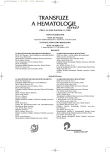Detection of minimal residual disease in acute lymphoblastic leukemia using quantification of immunoglobulin and T-cell receptor genes rearrangements. How to avoid misinterpretation of the results
Detekce minimální reziduální nemoci u akutních lymfoblastických leukemií pomocí kvantifikace přestaveb genů pro imunoglobuliny a T-buněčné receptory: jak se vyhnout špatné interpretaci výsledků
Hodnocení minimální reziduální nemoci u akutních lymfoblastických leukemií pomocí kvantifikace klonálně specifických přestaveb genů pro imunoglobuliny a T-buněčné receptory je v současné době považováno za standardní laboratorní postup. Výsledky této metody jsou stále častěji využívány v léčebných protokolech pro stratifikaci pacientů do rizikových skupin s různě intenzívní terapií nebo přímo pro volbu konkrétních léčebných postupů. Vzhledem k náročnosti metodiky je třeba dodržovat technická a interpretační kritéria, která umožňují plnou reprodukovatelnost metody a zaručují klinickou validitu výsledků. Autoři shrnují současný pohled na provádění a interpretaci této moderní laboratorní metody a upozorňují na možná rizika plynoucí z nedodržení těchto kritérií.
Klíčová slova:
akutní lymfoblastická leukemie; RQ-PCR; přestavby Ig/TCR; minimální reziduální nemoc
Authors:
E. Froňková; J. Trka
Authors‘ workplace:
Laboratorní centrum Kliniky dětské hematologie a onkologie, UK 2. LF Praha
; CLIP - Childhood Leukaemia Investigation Prague
Published in:
Transfuze Hematol. dnes,11, 2005, No. 3, p. 110-115.
Category:
Comprehensive Reports, Original Papers, Case Reports
Overview
Currently, qualification of clonal immunoglobulin and T-cell receptor rearrangements is considered to be a standard laboratory investigation to evaluate minimal residual disease in acute lymphoblastic leukemia. Benefit of this method contributes more often to therapeutic protocols that stratify patients into the groups according to the need of differently intensive therapy or particular therapeutic regimen. Regarding complexity of the method, it is necessary to follow technical and interpretative criteria that enable reproducibility and clinical validity of the method. The authors summarize current view on design and interpretation of this modern laboratory method. They also notice possible risks when these criteria were broken.
Key words:
acute lymphoblastic leukemia, RQ-PCR, Ig/TCR rearrangements, minimal residual disease
Labels
Haematology Internal medicine Clinical oncologyArticle was published in
Transfusion and Haematology Today

2005 Issue 3
- The Importance of Hydration in Wound Healing
- Cost Effectiveness of FVIII Substitution Versus Non-Factor Therapy for Hemophilia A
- Vascular Disease in the Gradually Aging Population of Hemophiliacs: An Underestimated Problem?
- Prognostic Significance of Subclinical Joint Changes on MRI in Hemophilia
- Immunotolerance is still the goal of management of hemophilia A with inhibitor in the era of non-factor therapy
Most read in this issue
- Hereditary hemochromatosis
- Benefit of the different sensitivity of aPTT reagent for diagnosis of lupus anticoagulant inhibitor
- LDL apheresis – evaluation of the results from 1000 performed procedures
- Detection of minimal residual disease in acute lymphoblastic leukemia using quantification of immunoglobulin and T-cell receptor genes rearrangements. How to avoid misinterpretation of the results
